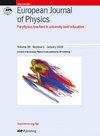学生在使用平方反比律矢量时容易犯的四个错误
IF 0.8
4区 教育学
Q4 EDUCATION, SCIENTIFIC DISCIPLINES
引用次数: 0
摘要
在本文中,我们讨论了物理入门学生在尝试将两个反平方律向量相加时所犯的四个错误。我们观察到学生在以下情况中多次犯错:(1) 将矢量当作标量进行相加;(2) 在试图找出矢量的分量时,投影分母中的 r(或 r2),而不是整个矢量;(3) 在试图计算结果矢量的大小时,错误地应用勾股定理;(4) 错误地将电场(或力)分量的符号与电荷的符号联系起来。虽然这些错误并不是学生们唯一会犯的错误,但根据我们对 678 份学生参加的力学入门或电学与磁学(E&M)考试的分析,它们是最常出现的错误。然后,我们展示了如何将这些错误编码成一种新型活动或评估问题,我们称之为 "学生错误任务"。物理入门课程的教师可以使用本文中的学生错误任务来吸引或评估学生对如何将两个反平方定律向量相加的理解。本文章由计算机程序翻译,如有差异,请以英文原文为准。
Four errors students make with inverse-square law vectors
In this paper, we discuss four errors introductory physics students make when attempting to add two inverse-square law vectors. We observe multiple instances in which students (1) add vectors as if they were scalars, (2) project the r (or r
2) in the denominator, instead of the entire vector, when attempting to find the vector’s components, (3) incorrectly apply the Pythagorean theorem when attempting to calculate the magnitude of the resultant vector, and (4) incorrectly relate the signs of the components of an electric field (or force) to the signs of the electric charges. While these are not the only errors students make, they are the most frequently occurring based on our analysis of 678 exams taken by students in either introductory mechanics or electricity and magnetism (E&M). We then show how these errors can be encoded into a new type of activity or assessment question which we call a ‘student error task.’ Introductory physics instructors can use the student error task in this paper as a way to engage or assess their students’ understandings of how to add two inverse-square law vectors.
求助全文
通过发布文献求助,成功后即可免费获取论文全文。
去求助
来源期刊

European Journal of Physics
物理-物理:综合
CiteScore
1.70
自引率
28.60%
发文量
128
审稿时长
3-8 weeks
期刊介绍:
European Journal of Physics is a journal of the European Physical Society and its primary mission is to assist in maintaining and improving the standard of taught physics in universities and other institutes of higher education.
Authors submitting articles must indicate the usefulness of their material to physics education and make clear the level of readership (undergraduate or graduate) for which the article is intended. Submissions that omit this information or which, in the publisher''s opinion, do not contribute to the above mission will not be considered for publication.
To this end, we welcome articles that provide original insights and aim to enhance learning in one or more areas of physics. They should normally include at least one of the following:
Explanations of how contemporary research can inform the understanding of physics at university level: for example, a survey of a research field at a level accessible to students, explaining how it illustrates some general principles.
Original insights into the derivation of results. These should be of some general interest, consisting of more than corrections to textbooks.
Descriptions of novel laboratory exercises illustrating new techniques of general interest. Those based on relatively inexpensive equipment are especially welcome.
Articles of a scholarly or reflective nature that are aimed to be of interest to, and at a level appropriate for, physics students or recent graduates.
Descriptions of successful and original student projects, experimental, theoretical or computational.
Discussions of the history, philosophy and epistemology of physics, at a level accessible to physics students and teachers.
Reports of new developments in physics curricula and the techniques for teaching physics.
Physics Education Research reports: articles that provide original experimental and/or theoretical research contributions that directly relate to the teaching and learning of university-level physics.
 求助内容:
求助内容: 应助结果提醒方式:
应助结果提醒方式:


